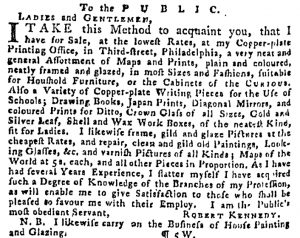What was advertised in a colonial American newspaper 250 years ago today?

“I likewise frame, gild and glaze Pictures at the cheapest Rates.”
According to his advertisement in the Pennsylvania Gazette, Robert Kennedy provided a variety of goods and services at his “Copper-plate Printing Office, in Third-street, Philadelphia.” To entice potential customers, he extolled both the wares he sold and personal attributes that qualified him to pursue his occupation. Kennedy was no mere middleman who shuttled imported goods through his shop; instead, he was a craftsman who altered and improved his merchandise to conform to the tastes and desires of his customers.
Kennedy stocked a “general Assortment of Maps and Prints” that were “neatly framed and glazed” in a variety of sizes and fashions. Customers could choose among these items to decorate their homes. Alternately, they could bring their own prints to Kennedy’s shop for him to “frame, gild and glaze” and otherwise prepare them to be exhibited in homes, either as “Houshold Furniture” or in “Cabinets of the CURIOUS.” His other services included cleaning, repairing, and gilding paintings and looking glasses as well as painting houses and installing windows.
Lest potential customers fear that he might irreparably damage their irreplaceable possessions, Kennedy assured them that he “had several Years Experience.” During that time he “acquired such a Degree of Knowledge of the Branches of my Profession” that he would be able to “give Satisfaction” to any of his customers. Notably, Kennedy underscored his expertise in various “Branches” of preparing paintings and prints for display. He did not want prospective clients to worry or suspect that he specialized in one task and dabbled in the others. Instead, through years of experience he had developed expertise in each of the services he offered.
In his description of framed maps and prints as “Houshold Furniture,” Kennedy revealed the value colonists placed on these items. They were part of a culture of conspicuous consumption that included the exhibition of consumer goods to signal taste and status. In addition to clothing, housewares, and furniture, colonists displayed framed maps, prints, and paintings as testaments to their gentility and adherence to current fashions. These decorative items needed to withstand keen observation, which made Kennedy’s experience and expertise all the more important. Part of the “Satisfaction” that he marketed to customers was confidence that the quality of his work would impress their visitors who viewed the items he framed, gilded, and repaired.
